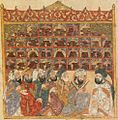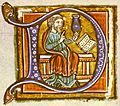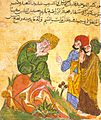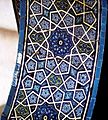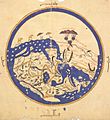Islamic Golden Age facts for kids
The Islamic Golden Age, also sometimes known as the Islamic Renaissance, was a very important period in history. It generally lasted from the 8th century to the 13th century. Some experts even think it continued into the 15th and 16th centuries.
This time was called a "Golden Age" because people in the Islamic world made huge advancements. Engineers, scholars, and traders achieved great things. They improved the arts, agriculture, economics, industry, law, literature, navigation, philosophy, sciences, and technology. They built on older ideas and added many new inventions and discoveries. As historian Howard R. Turner said, "Muslim artists and scientists, princes and laborers together created a unique culture that has directly and indirectly influenced societies on every continent."
Contents
Amazing Discoveries and Inventions
During the Islamic Golden Age, many smart people made incredible progress. They focused on learning and discovery. This led to new ideas that changed the world.
Science and Medicine
Scholars made big leaps in science and medicine. They studied the human body and found new ways to treat illnesses.
Medical Advancements
Doctors like Hunayn ibn Ishaq translated important medical texts. They also wrote their own books. These books described how the eye works and how to perform surgeries. Hospitals were built, like the Mansuri hospital in Cairo. These places were centers for healing and learning.
Astronomy and Mathematics
People also looked to the stars. They used tools like the astrolabe to understand the sky. This helped them with navigation and telling time. In mathematics, they developed algebra and improved geometry. These ideas are still used today in many fields.
Arts and Culture
The Islamic Golden Age was also a time of beautiful art and rich culture. Artists created stunning designs and writers told amazing stories.
Architecture and Patterns
Buildings from this time show amazing geometric patterns. You can see them in mosques and other structures. These patterns are very detailed and often use stars and other shapes.
Literature and Music
Writers produced many famous books. These included stories, poems, and scientific works. Musicians also created new instruments and theories. The lute, for example, was a popular instrument.
Trade and Innovation
Trade routes connected the Islamic world to many other regions. This helped new ideas and goods spread.
Agricultural Innovations
New farming methods were introduced. Crops like sugarcane spread from India to Spain. This improved food production and trade.
Everyday Technologies
Many everyday items were also improved. For example, paper-making became more common. This helped spread knowledge through books and manuscripts.
Images for kids
-
The Christian physician Hunayn ibn Ishaq lead the translation of works
-
A manuscript written on paper during the Abbasid Era.
-
An Arabic manuscript from the 13th century depicting Socrates (Soqrāt) in discussion with his pupils
-
Geometric patterns: an archway in the Sultan's lodge in the Ottoman Green Mosque in Bursa, Turkey (1424), its girih strapwork forming 10-point stars and pentagons
-
Astrolabe with Quranic inscriptions from Iran, dated 1060 AH (1650-51 AD)
-
The eye, according to Hunain ibn Ishaq. From a manuscript dated circa 1200.
See also
 In Spanish: Edad de Oro del islam para niños
In Spanish: Edad de Oro del islam para niños


